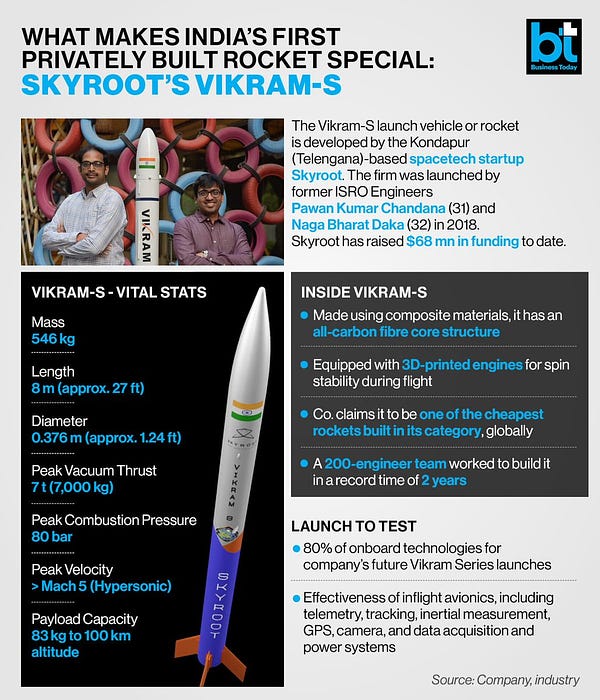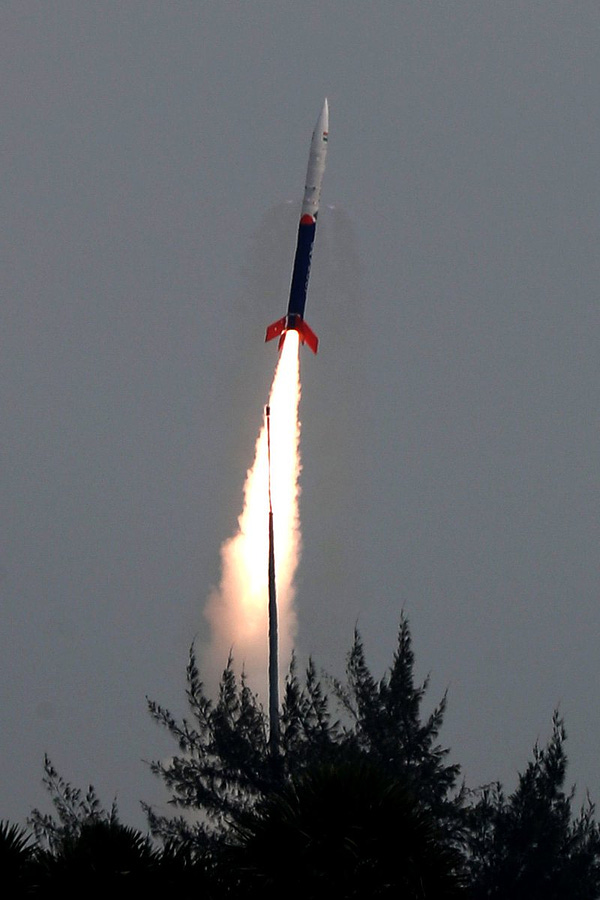Going to Space - Privately
The first private Indian launch company successfully reached orbit on its very first attempt
I had to write two articles this week because space launches are not a sure thing. What if nothing got launched?
Having this piece go out at a time when it is possible to juxtapose this with the Artemis I launch which cost the equivalent of the GDP of a small island nation is just great. NASA has spent an estimated $93 billion on the development of this rocket and each launch is expected to cost $4 billion. After months of delay, the Artemis I finally lifted off the Kennedy Space Center and headed for the moon. By the time you read this, it would have already reached the moon.
India’s space ambitions started out of an abandoned church by the sea in Kerala in the late 1960s. Sitting in the church in the baking heat our former president Abdul Kalam along with Satish Dhawan would assemble and launch Sounding Rockets to get weather reads. Most sounding rockets do not reach the altitude needed to deploy satellites and they are fashioned out of leftover parts from military rockets.
This location was picked because it was close to the magnetic equator of the Earth. This would become India’s first space launch port and be named Thumba Equatorial Rocket Launch Station (TERLS). Being located close to Trivandrum posed security issues and hence another site, an island off the coast of the Bay of Bengal was chosen 6 years later. An island called Sriharikota would house the new launch centre which was called Sriharikota Range (SHAR for short).
Indian space ambitions have come a long way since.
India still does not have a launcher that can be used for deep space launches but we have often overcome that by using the Earth’s gravity.
The rise of SpaceX caused a host of space startups to emerge across the world. New Zealand was the first to offer support to space startups and thus emerged Rocket Labs. A company that is 3D printing rockets and sending them to space (damn cheap!). If they scale, they will make SpaceX look like a money-guzzling enterprise.
India by comparison decided to be left behind, quite literally, as long as possible.
In June 2020, the country established Indian National Space Promotion and Authorisation Centre (IN-SPACe). This would become the single window agency for all space startups and space businesses. It would also be the window through which access to various ISRO assets such as the launch ports will be enabled.
Today there are 53 space startups in India, and to the best of my knowledge, there is only one launch vehicle company.
In 2018, during one of my visits to Hyderabad, on a whim, I dropped a message over LinkedIn to Pawan asking if he could make half an hour to meet. I knew he had started a space launch vehicle startup. Within minutes he sent across his address and asked me to drop in. Pawan is an ex-ISRO employee who along with a few others had taken the bold decision to build a private launch vehicle business. He had encouragement from ISRO and at the time Mukesh Bansal was bankrolling them with the money he had made from the Myntra exit. Pawan was very appreciative of the fact that Mukesh was willing to take such a risk with his own money. Mukesh put in $1.5 million of his own money.
Pawan was seeking to raise $10 Million at the time and found that none of the VCs in India had the gumption to pursue the deal. $10 million is what NASA probably spends on devising a screwdriver that they could use in space. Pawan was expecting to have a working engine for that much!
I had put him across to a few VCs all for nothing. Everyone was looking for the next SaaS venture that they could palm off in an M&A deal. So-called “Deep-Tech” funds were just looking for AI startups which were definitely not deep and barely tech.
The team at Skyroot kept building and kept looking for cash. Finally, in May 2021, they managed to raise the $11 Million that they had been looking for since 2018. Not from a VC though. It made it possible for the company to successfully test-fire their engine.
Since then, money has been pouring into the venture thick and fast. They have raised more than $50 million this year alone.
At the same time, the company had been lobbying the government through ISRO to allow private launch companies. This effort resulted in the IN-SPACe program mentioned above.
When I met Pawan in 2018, he said the problem is just lining up the money to get the rocket built. He was so certain about building the rocket. The technology is not all that difficult to replicate. The business is rather straightforward. There are enough and more payloads waiting for a vehicle. True to his word, for the very first launch, they lined up three payloads.
The rocket is scheduled to take off from the Indian Space Research Organization’s (ISRO) Sriharikota launch pad between November 12 and 16, matching the weather conditions with Skyroot cofounder and CEO Pawan Kumar Chandana as the mission director.
Vikram-S, named as a tribute to ISRO founder and renowned scientist Vikram Sarabhai, received its technical launch clearance from the space regulator IN-Space and comes shortly after the spacetech startup raised $51 Mn in funding.
Mission Prarambh will carry three customer payloads on Skyroot’s indigenously made launch vehicle and help test and validate the majority of the technologies in the Vikram series of space launch vehicles.
Source: Inc42
The launch was pushed from the 15th to the 18th of November. On the 8th of November, a depression from the Bay of Bengal hit the Eastern coast of India causing inclement weather for a few days.


Today, India got its first private space launch company that successfully deployed three payloads on the first attempt.


This is quite an achievement for a fledgling company that was strapped for cash. They have two larger variants under development. They are certainly going to be more competitive in terms of cost than most of the other companies across the globe.
It is a new beginning for the space industry in India.



